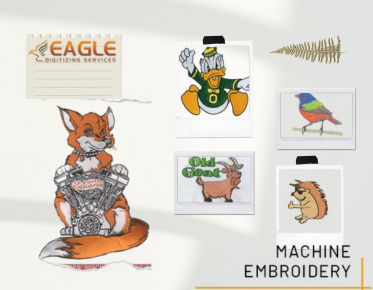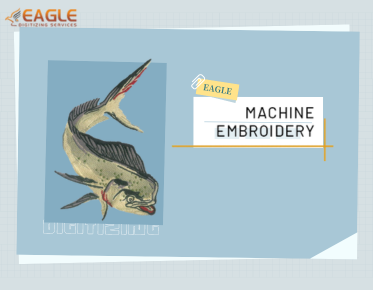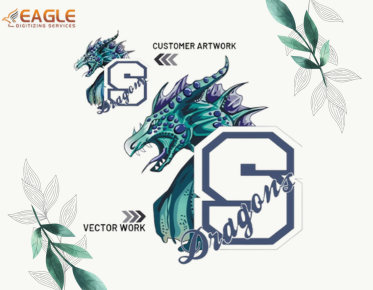Embossing vs. Embroidery: Quality Showdown/Eagle Dgitizing
When it comes to enhancing the visual and tactile appeal of products, both embossing and embroidery offer unique benefits. These techniques, though different in execution and outcome, serve to elevate brand image, create memorable embroidery designs, and add a touch of sophistication to a variety of items. Understanding their nuances helps in choosing the right method for your needs.
Defining
Embossing: What You Need to Know
Embossing is a process that creates raised designs on a material by pressing it with a patterned die. This technique is commonly used on paper, leather, and other pliable materials to add texture and dimension. Embossing is often employed in business cards, stationery, and luxury packaging to impart a sense of elegance and professionalism.
Understanding
the Basics of Embroidery
Embroidery, on the other hand, involves Embroidery stitching threads into fabric to create patterns and images. This age-old craft can be done by hand or machine, resulting in richly textured and colorful designs. Embroidery is widely used on apparel, accessories, and home décor items, offering a blend of durability and aesthetic appeal.
A
Brief History: Embossing vs. Embroidery
Embossing has its roots in ancient metalworking and bookbinding techniques, where it was used to decorate and distinguish valuable items. Embroidery dates back even further, with early examples found in ancient Egyptian, Chinese, and Persian cultures, symbolizing wealth and status. Both techniques have evolved over centuries, adapting to modern technologies and materials while retaining their artisanal charm.
Craftsmanship
and Techniques
The Art of Embossing: Tools and
Methods
Embossing requires precise tools and methods to achieve clean, sharp
lines. Dies, which are engraved with the desired pattern, are pressed onto the
material using a combination of heat and pressure. The result is a crisp,
raised design that can be felt as well as seen.
Hand vs. Machine Embroidery
Techniques
Embroidery can be performed by hand, offering unparalleled flexibility and detail, or by machine, which provides consistency and speed. Hand embroidery allows for intricate, personalized touches, while machine embroidery is ideal for larger-scale production and complex patterns.
Detail
and Precision in Design
Embossing: Sharp Lines and Clean
Edges
Embossing excels in creating sharp, precise lines and clean edges. The
raised design is uniformly smooth and adds a subtle yet impactful dimension to
the material. This makes embossing particularly suitable for logos, monograms,
and decorative borders.
Embroidery: Intricate Stitches
and Textures
Embroidery shines in its ability to create intricate stitches and varied textures. The interplay of threads can produce depth, shading, and vibrant color combinations that are visually striking. Embroidered designs have a tactile richness that invites touch, enhancing the sensory experience of the product.
Material
Compatibility
Best Materials for Embossing
Embossing works best on sturdy, flexible materials such as paper,
leather, and some plastics. The material needs to hold the raised design
without tearing or losing definition. Embossing on these materials can achieve a
high level of detail and durability.
Ideal Fabrics for Embroidery
Embroidery is versatile and can be applied to a wide range of fabrics, including cotton, polyester, silk, and even canvas. The choice of fabric can influence the final look and feel of the embroidery, with thicker fabrics providing a more pronounced texture.
Durability
and Longevity
How Embossing Holds Up Over Time
Embossed designs are generally very durable, especially when applied
to high-quality materials. The raised pattern is resistant to wear and tear,
maintaining its integrity over time. However, extreme pressure or rough
handling can potentially flatten or damage the embossed areas.
The Wear and Tear of Embroidered
Designs
Embroidery is highly durable, with the stitched patterns holding up well to regular use and washing. Quality threads and proper stitching techniques ensure that embroidered designs remain intact and vibrant for a long time. However, frequent laundering and abrasive use can cause threads to fray or colors to fade.
Visual
and Tactile Appeal
The Look and Feel of Embossed
Products
Embossed products have a sophisticated, understated elegance. The
raised designs catch light in interesting ways, creating subtle shadows and
highlights that enhance the visual appeal. The tactile quality of embossing
adds an extra dimension, making products feel premium and luxurious.
The Texture and Depth of
Embroidery
Embroidery offers a rich, textured appearance that can be both visually and tactilely stimulating. The interplay of different stitches and thread colors creates depth and dimension, making designs come alive. Embroidered items often feel handcrafted and bespoke, adding a personal touch.
Versatility
in Applications
Embossing on Paper, Leather, and
More
Embossing is highly versatile and suitable for a variety of materials
beyond paper and leather. It can be used on metal, wood, and even some
plastics, making it ideal for a wide range of products from book covers and
business cards to packaging and luxury goods.
Embroidery on Clothing,
Accessories, and Home Decor
Embroidery’s adaptability makes it perfect for clothing, accessories, and home decor items. From embroidered logos on corporate apparel to decorative cushions and throws, the possibilities are endless. Embroidery can transform everyday items into unique, branded pieces.
Customization
Options
Personalizing with Embossing
Embossing allows for precise personalization, adding individual names,
initials, or custom designs to products. This level of customization is perfect
for creating personalized stationery, bespoke leather goods, and high-end
packaging that stand out.
Tailoring Designs with
Embroidery
Embroidery offers extensive customization options, from choosing specific thread colors and stitch types to incorporating detailed patterns and logos. This flexibility makes it easy to tailor designs to match brand aesthetics or personal preferences, ensuring each piece is unique.
Cost
Considerations
Expense of Embossing: What to
Expect
Embossing can be relatively cost-effective, especially for large runs,
but the initial setup costs for dies can be high. The choice of material and
complexity of the design also affect the overall cost. For small-scale or
one-off projects, embossing might be less economical.
Budgeting for Quality Embroidery
Embroidery costs can vary widely based on factors like design complexity, stitch count, and fabric choice. While machine embroidery is more affordable for bulk orders, hand embroidery can be more expensive due to the labor-intensive process. Investing in quality materials and craftsmanship ensures long-lasting and impressive results.
Production
Time and Efficiency
Speed of Creating Embossed Items
Embossing is relatively quick once the dies are created, making it
efficient for large-scale production. Automated embossing machines can produce
high volumes in a short time, which is ideal for commercial projects.
Time Investment in Embroidery
Projects
Embroidery, particularly hand embroidery, can be time-consuming. Machine embroidery is faster and suitable for larger orders, but still requires careful setup and quality control. The time investment is often reflected in the detailed and intricate results that embroidery can achieve.
Eco-Friendliness
and Sustainability
Sustainable Practices in
Embossing
Eco-friendly embossing practices include using recyclable materials,
non-toxic inks, and energy-efficient machinery. Sustainable embossing not only
reduces environmental impact but also appeals to environmentally conscious
consumers.
Eco-Friendly Embroidery Techniques
Sustainable embroidery techniques involve using organic fabrics, and biodegradable threads, and minimizing waste. Choosing suppliers who adhere to ethical practices ensures that embroidery projects are environmentally friendly.
Branding
and Professional Image
Using Embossing for Elegant
Branding
Embossing is perfect for creating an elegant and professional brand
image. It adds a touch of class to business cards, packaging, and promotional
materials, making a lasting impression on clients and customers.
Enhancing Brand Identity with
Embroidery
Embroidery enhances brand identity by adding a personal and tactile element to branded apparel and accessories. It conveys a sense of tradition, quality, and attention to detail, reinforcing brand values and professionalism.
Maintenance
and Care
Caring for Embossed Items
Embossed items require gentle handling to maintain their raised
designs. Avoid excessive pressure and store them properly to prevent
flattening. Cleaning should be done carefully to avoid damaging the embossed
areas.
Maintaining Embroidered Products
Embroidered products need proper care to keep them looking their best.
Washing in cold water, avoiding harsh detergents, and air drying can help
preserve the colors and integrity of the stitches. Regularly inspecting for
loose threads and addressing them promptly extends the life of embroidered items.
Customer
Perception and Preference
What Customers Love About
Embossing
Customers appreciate the elegance and sophistication of embossed
products. The tactile quality and high-end feel of embossing make it a popular
choice for luxury items and special occasions.
Why Some Prefer Embroidery
Embroidery is loved for its intricate designs and personalized touch. Customers value the craftsmanship and durability of embroidered items, making them a preferred choice for gifts, apparel, and home decor.
Challenges
and Limitations
Common Issues with Embossing
Embossing can be limited by the material's thickness and flexibility.
Intricate designs may not translate well onto certain surfaces, and the initial
setup cost for custom dies can be high.
Embroidery Pitfalls and How to
Avoid Them
Embroidery can face challenges like thread breakage, fabric puckering, and color fading. Using high-quality materials, proper techniques, and regular maintenance can mitigate these issues and ensure excellent results.
Future
Trends and Innovations
The Future of Embossing
Techniques
Innovations in embossing include digital embossing and eco-friendly
materials, offering more design possibilities and sustainable options. As
technology advances, embossing will continue to evolve, providing even more
creative opportunities.
Emerging Trends in Embroidery
Embroidery is seeing a resurgence in personalized and bespoke designs, with trends like 3D embroidery and the use of unconventional materials gaining popularity. The integration of smart textiles and wearable technology also represents an exciting frontier.
Choosing
the Right Technique
Both embossing and embroidery have their unique advantages and challenges. Embossing offers sharp, elegant designs perfect for paper and leather, while embroidery provides rich, textured patterns suitable for a wide range of fabrics.
Consider the specific requirements of your project, including
material, design complexity, budget, and intended use. Whether you choose the
refined elegance of embossing or the intricate detail of embroidery, both
techniques can significantly enhance your brand image and product appeal. With
Eagle Digitizing's expert embroidery digitizing services, you can ensure your designs are flawlessly translated into
stunning embroidered works of art.



